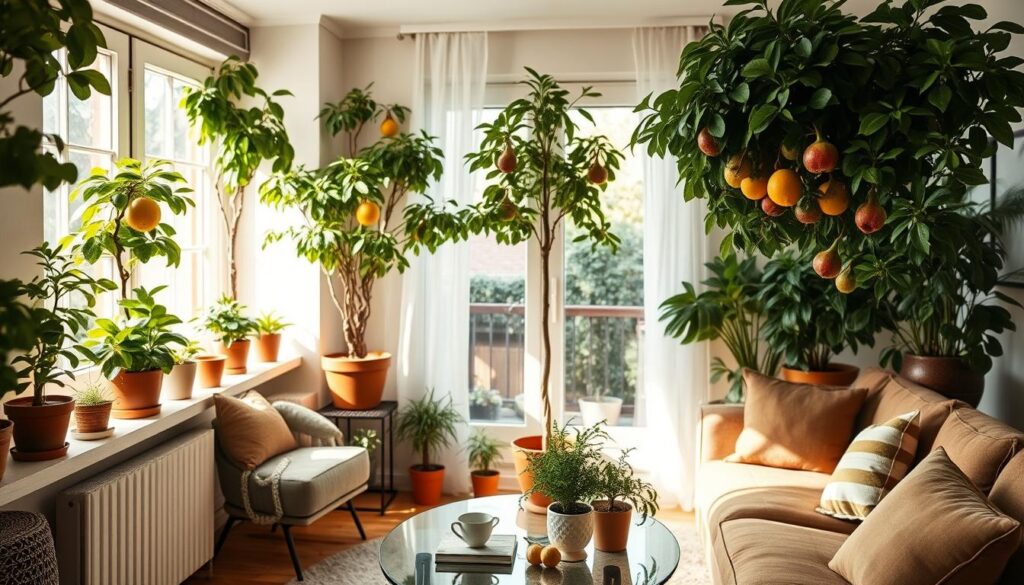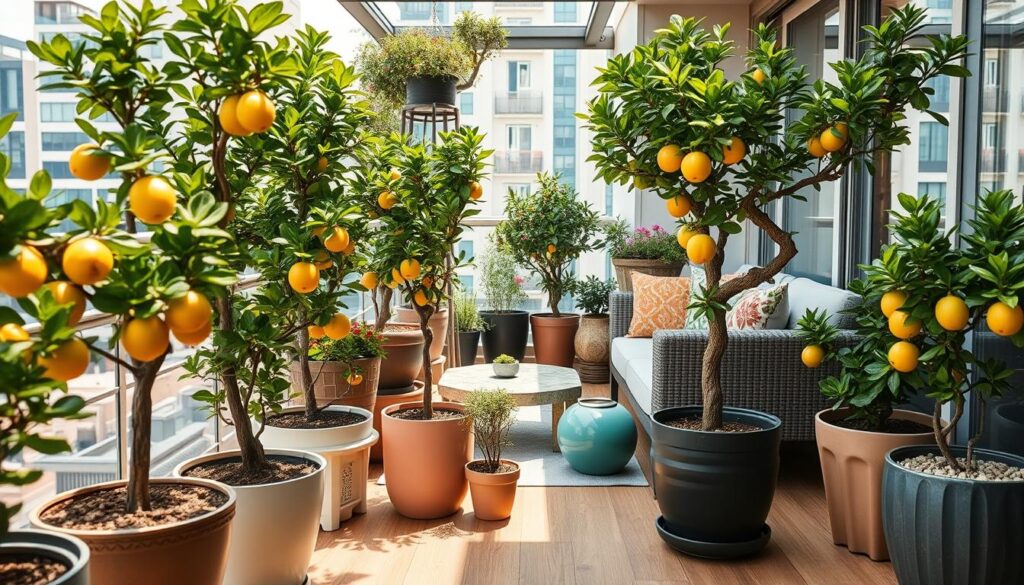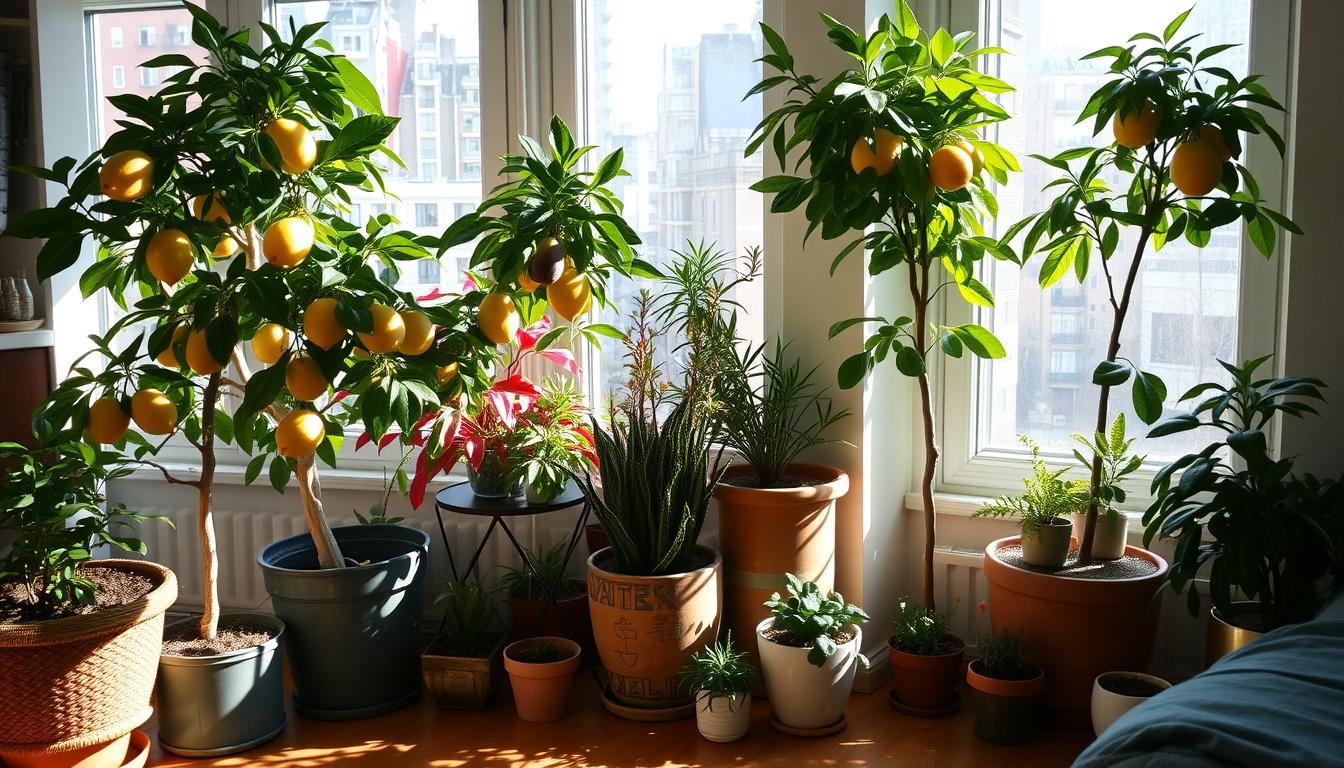Bringing nature into urban spaces is easier than ever, thanks to the best indoor fruit trees for apartments. As someone who loves urban gardening, I’ve found growing fruit indoors to be rewarding. It adds freshness and color to my home. Whether it’s a small herb patch or a full apartment orchard, the right trees can thrive in pots.
More people are enjoying the joy of growing their own food, leading to a rise in interest in these plants. With some effort, I can grow nutritious fruits and make my home look better. For those eager to explore indoor gardening, GardenBeginner.com is a great resource, offering helpful tips and a supportive community.
Key Takeaways
- Indoor fruit trees are perfect for making urban living spaces better.
- Proper care is key to growing fruit indoors successfully.
- Humidity and light are crucial for tree health.
- Choose varieties that do well in apartments.
- Turning living spaces into green oases is possible.
Introduction to Indoor Fruit Trees
Indoor fruit trees are now a hit with city folks who love indoor gardening. These small trees are made for apartments, letting me grow many fruits without a big outdoor area. They make my home look better and grow well in small spaces.
There’s a wide choice of indoor fruit trees. For example, Meyer lemons start bearing fruit in 2 to 3 years. Dwarf banana plants can bloom in 9 to 15 months. These trees give me fresh fruit and make my home feel welcoming.
The trend of urban gardening lets apartment dwellers grow their own fruits. I can pick from many indoor-friendly trees like figs, citrus, and dwarf apples. With the right care, these trees can grow well and give me delicious fruit, making my hobby rewarding.
Exploring indoor fruit trees, I learn about their needs and benefits. Knowing how to care for them lets me create a mini orchard in my apartment. It’s fulfilling to grow and enjoy these fruits.
Benefits of Growing Indoor Fruit Trees
Growing indoor fruit trees brings many benefits to my home and life. These plants offer fresh produce and make my living space better. They add unique flavors, save money, and make my home look great.
Unique Flavor Sensations
One great thing about indoor fruit trees is the unique flavors they offer. When I pick fruits, they taste much better than store-bought ones. This makes my meals and snacks taste like gourmet dishes.
Reducing Grocery Costs
Another big plus is saving money on groceries. Growing my own fruits means I don’t have to buy expensive produce. I can enjoy fresh fruits all year, which is cheaper in the long run.
Aesthetic Appeal in Living Spaces
Indoor fruit trees also make my living spaces look better. Their bright colors and natural shapes make my home feel calm and welcoming. They are beautiful decorations that fit well with my home’s style.
Choosing the Right Indoor Fruit Tree
When picking indoor fruit trees, I need to think about a few key things. The right tree can make my home look great and give me yummy fruits all year. It’s all about finding the perfect match.
Consider Size and Space
It’s important to know how much space I have for my tree. Most good indoor trees are small, under 8 feet tall. For example, Meyer lemon trees do well indoors and don’t need a lot of room.
Dwarf citrus trees like calamondin and small oranges are also great for small spaces. Choosing self-pollinating trees is smart too. They grow well on their own, without needing other plants.
Light and Water Requirements
Every indoor fruit tree has its own light and water needs. Most need at least six hours of direct sunlight a day. If my place doesn’t get much sun, I can pick trees that don’t need as much.
Watering is also important. Indoor trees need more water when it’s warm and less when it’s cool. Keeping the room between 55 and 85 degrees is best for them. For more tips on caring for indoor fruit trees, I can check out useful advice online.

Best Indoor Fruit Trees for Apartment Living
Starting an indoor garden opens up many options. I’ve found some top indoor fruit trees that do well in small spaces. They also add delicious fruits and a unique look to your home.
Fig Trees
Fig trees, like the Petite Negra, are perfect for indoor gardens. They need little care and start giving fruit when they’re small. Fresh figs add a tasty touch to any meal, making my garden both useful and tasty.
Citrus Varieties
Citrus plants, like Meyer Lemon and Calamondin oranges, love lots of sunlight. They need 8 to 12 hours of direct sun each day. A sunny window is the best spot for them. Their scent makes my home feel lively and fresh.
Dwarf Apple Trees
Dwarf apple trees, like Fuji and HoneyCrisp, are great for indoor gardens. They offer tasty apples and grow well in small spaces. They need about 6 to 8 hours of light a day to do well.
Banana Plants
Banana plants love sunny spots with lots of humidity. They look lush and tropical, and can grow bananas in a year or two. They make my home look beautiful and give me a fun fruit to pick.
Caring for Your Indoor Fruit Trees
Effective indoor fruit tree care is key for their growth. These trees need lots of sunlight, at least six to eight hours a day. Citrus trees need even more, around eight to twelve hours. A bright space helps them grow well and produce lots of fruit.
Plant maintenance includes choosing the right pots. Make sure your pots have holes for drainage to avoid root rot. Use the right soil mix, like loamy soil for figs and slightly acidic for citrus. Water when the top inch of soil feels dry to keep the roots healthy.
During the growing season, use a balanced fertilizer monthly. Organic fertilizers like compost or worm castings are great. For pests, use insecticidal soaps or neem oil to keep your trees healthy.
By focusing on these care tips, your trees will grow well. Watch out for diseases like root rot and powdery mildew. With proper watering and care, your indoor fruit tree garden will flourish.
| Tree Type | Sunlight Requirement | Watering Frequency | Fertilizer Type |
|---|---|---|---|
| Citrus (e.g., Meyer Lemon) | 8-12 hours | When top inch dries | Organic balanced |
| Fig (Brown Turkey) | 6-8 hours | When top inch dries | Compost |
| Avocado | 6-8 hours | When top inch dries | Worm castings |
| Dwarf Banana (Super Dwarf Cavendish) | 6-8 hours | When top inch dries | Balanced fertilizer |
Following these tips has made my indoor gardening better. If you’re thinking about growing indoor fruit trees, knowing these care tips is a big help. For more on keeping your garden healthy, check out this information.
Top Dwarf Fruit Trees for Small Spaces
Dwarf fruit trees are perfect for those with little indoor space. They let me grow many fruits without needing a lot of room. Ultra-dwarf fruit trees are especially great for apartment living. They can go on balconies or inside, thriving in containers and adapting to different indoor spots.
Ultra-Dwarf Varieties
Several ultra-dwarf fruit trees are great for small areas. Here are some top picks:
- Ultra-Dwarf HoneyCrisp Apple: This variety grows 5-8 feet tall and does well in containers, perfect for small spaces.
- Dwarf Cavendish Banana: It grows up to 6 feet tall and fits well in cozy spots.
- Meyer Lemon: Reaching 6 to 8 feet tall, it offers sweet, yellow fruits in summer and does great in pots.
- Celeste Fig: This tree grows 5 to 10 feet tall and is suitable for many zones.
- Dwarf Pomegranate ‘Nana’: It grows up to 3 feet tall, bearing fruit and showing off beautiful blooms.
Maintenance Tips
Keeping dwarf fruit trees healthy and fruitful requires good care. Here are some key tips:
- Watch the light they get; make sure they get enough sunlight based on their needs.
- Water them often but don’t overdo it, as too much water can cause root rot. Keeping the soil a bit moist is best.
- Fertilize them often during the growing season to help them grow strong and produce fruit.
- Prune them right to keep them the right size and shape. This also helps with air flow and light.

Creating an Indoor Orchard
Turning my apartment into a vibrant oasis with fruit-bearing trees is exciting. I choose versatile varieties that grow well in small spaces. This way, I can enjoy fresh fruits all year, making my urban gardening more enjoyable.
Most fruit trees need at least six hours of sunlight a day. I make sure my trees get enough light for them to grow and produce fruit well.
Diverse fruit trees add different flavors and looks to my space. Dwarf fruit trees do great in containers, perfect for small areas. Regular pruning keeps them small and encourages growth. Some trees might need hand pollination because they lack natural pollinators indoors.
To make the most of my space, I use vertical gardening. I stack pots or use wall-mounted planters. This lets me grow more plants without taking up too much room. I must water carefully to avoid root rot, waiting until the soil feels dry.
Here’s a glimpse of some suitable indoor fruit trees for my orchard:
| Fruit Tree | Size | Light Requirements | Notes |
|---|---|---|---|
| Meyer Lemon | Dwarf | 6-8 hours | Produces fruit easily indoors |
| Dwarf Apple | Dwarf | 6-8 hours | May need help with pollination |
| Guava | Medium | Sunny spots required | Good drainage essential |
| Olive Tree | Dwarf | 4-6 hours | Tolerates dry conditions |
By following these tips, I can create a thriving indoor orchard. It will not only make my space look beautiful but also give me fresh fruits. With the right care, like proper fertilization and watering, I’ll get a good harvest. Looking for more urban gardening strategies can help me succeed in this rewarding project.
Urban Gardening: Transforming Your Apartment
Urban gardening turns my apartment into a green oasis. I use small space gardening tips to make it welcoming. Vertical planting lets me grow plants on walls, keeping the floor clear.
Light is key for my garden. I place sun-loving herbs like rosemary near south-facing windows. Shade-tolerant herbs like parsley do well in darker spots, showing even small spaces can be green.
I use a hydroponic system for bigger plants like lettuce. The AeroGarden® Farm 12 grows up to 12 plants 5X faster. Its LED lights adjust automatically, making care easy.
Choosing the right pots is important. I look at size, space, and looks. Lightweight, weather-resistant pots make care easier. Premium potting mixes like Miracle-Gro® Performance Organics® help plants grow strong.
These tips not only make my space look good but also help the planet. Gardening reduces stress and boosts mood. For more tips, read this article on indoor farming.
Common Challenges and Solutions
Growing indoor fruit trees can be tricky, especially with pests. It’s key to manage pests to keep your trees healthy. Using pest management for indoor trees and Integrated Pest Management (IPM) helps. These methods keep pests in check while supporting good bugs.
Pest Management
Staying ahead of pests is crucial. I check my plants for pests like aphids and spider mites. Catching problems early is vital.
Using traps and natural predators like ladybugs helps control pests. Good air flow and watering also help keep pests away.
Proper Pruning Techniques
Pruning is another big challenge. I focus on pruning indoor fruit trees to keep them healthy. Pruning helps with air flow and light.
Removing dead or crowded branches is key. Using sharp tools helps the plants heal faster. Pruning in the dormant season boosts spring growth.
| Challenge | Solution |
|---|---|
| Pest Infestations | Implement Integrated Pest Management (IPM) strategies to maintain balance. |
| Insufficient Air Circulation | Regular pruning to improve airflow around branches. |
| Overwatering or Underwatering | Monitor soil moisture levels to adjust watering frequency. |
| Low Light Conditions | Position plants near bright windows or use grow lights. |
For more tips on growing indoor citrus, check out growing citrus trees indoors. It can help you tackle similar issues.
Conclusion
Starting my indoor fruit garden has been very rewarding. Growing trees like Meyer lemons and olive trees makes my home look better. Plus, I get fresh fruits that are hard to find in stores.
The Improved Meyer Lemon tree, for example, is a big hit. It’s full of vitamin C and tastes amazing. By knowing what each tree needs, I can make my home a lush oasis.
But, taking care of these trees is a big job. I need to water them often, prune them right, and keep the soil healthy. Even though lemon trees cost about €81.00, they’re worth it for the fresh fruit.
Olive trees, priced at around €49.00, are a great deal too. They’re full of antioxidants and add a special touch to Mediterranean dishes.
Dealing with indoor gardening challenges has taught me a lot. It’s all about learning to manage pests and create the perfect environment. Every problem is a chance to grow and improve.
I’m looking forward to seeing my trees grow and the delicious fruits they’ll produce. My dedication to gardening means my home will always be a place of greenery and tasty treats.



Leave a Reply